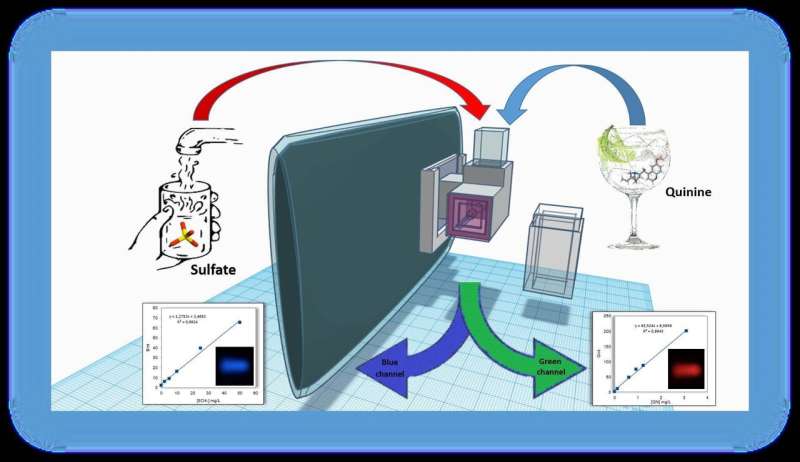Credit: RSC Advances
Researchers from the University of Alicante (Spain) and the Universidad Nacional del Sur (Argentina) have designed and validated a low-cost 3-D printed device that, connected to a smartphone, makes it possible to conduct chemical analyses. This technology presents a simple solution for on-site testing, in developing countries or remote locations, without the need to step into the laboratory or access advanced technology.
Smartphones have a wide range of options beyond everyday simple applications. In addition, 3-D-printed devices are becoming more accessible and allow us to create not only simple parts but also complete determination systems, as researcher from the UA Department of Analytical Chemistry, Nutrition and Bromatology Miguel Angel Aguirre explains. Within this framework, the device created by the team of Spanish and Argentinean researchers helps us reduce costs and simplify the technology. Its impact could be considerable in places where there are no accessible laboratories. Furthermore, it can generalize the use of inexpensive and portable detection instruments.
The work has been published as a hot article in the RSC Advances journal, published by the UK's Royal Society of Chemistry.
This new versatile detection system is an excellent choice for fast and accurate nephelometric and fluorometric measurements of carbonated soft drinks (tonic) and water samples. Compared to reference fluorimetric and nephelometric methods, which require non-portable laboratory equipment, the proposed method applies the same chemical reagents, providing a portable and economical system for on-site determinations, especially in regions with limited resources, as confirmed by the UA researcher.
In particular, the tests have revealed the concentration of quinine in tonic drinks, as well as concentrations of sulfate in drinking water samples below the maximum values allowed by European Council Directive 98/83/EC. The sulfate determination has been carried out by nephelometry using a red LED, while the quinine was determined using a blue LED with fluorimetry, Miguel Ángel Aguirre stated.
The device has been developed using 3-D printing technology and employing the smartphone camera to complete the determination. This system offers enormous potential for in situ environmental, biochemical, and food control determinations. The possibility of having several sources of radiation extends the possible applications of the system by only using the camera of a smartphone as a capture device.
According to the researchers, there are currently no similar devices on the market. Some items have been described in the scientific literature as having similar features but not developing both types of analytical methods—fluorimetric and nephelometric techniques.
The device designed by the University of Alicante and the Argentinian Universidad Nacional del Sur could be adapted to any type of smartphone and for various uses such as chemiluminescent reactions or reading paper-based analytical microdevices.
More information: Ezequiel Vidal et al. New, inexpensive and simple 3D printable device for nephelometric and fluorimetric determination based on smartphone sensing, RSC Advances (2020). DOI: 10.1039/D0RA02975K
Provided by Asociacion RUVID
























